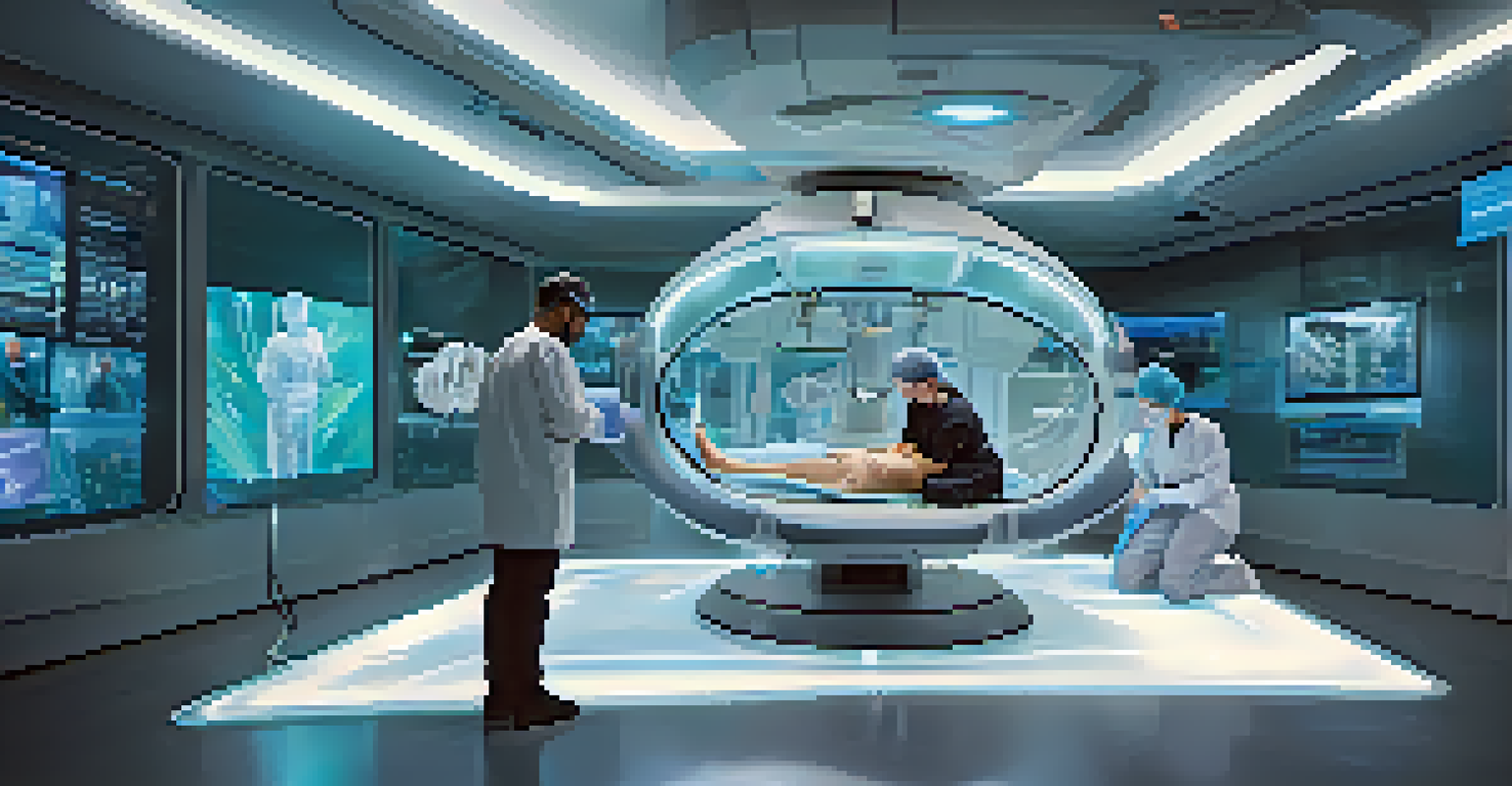The Impact of Virtual Reality on Future Work Environments

Introduction to Virtual Reality in the Workplace
Virtual reality (VR) is no longer just a tool for gaming; it's making significant inroads into the workplace. As companies seek innovative ways to enhance productivity and collaboration, VR presents a unique solution. By immersing employees in a fully interactive environment, VR offers them a fresh perspective on their tasks and collaborations.
Virtual reality is the perfect tool for training and collaboration in the workplace, offering immersive experiences that traditional methods simply cannot match.
Imagine stepping into a virtual office where you can interact with colleagues from around the globe as if they were right next to you. This level of engagement can foster creativity and teamwork, breaking down geographical barriers that traditional office settings impose. With advancements in VR technology, this scenario is becoming increasingly feasible.
From training to virtual meetings, the applications of VR in the workplace are vast. As we delve deeper into this topic, we’ll explore how VR can revolutionize various aspects of work life, ultimately leading to a more productive and engaged workforce.
Enhancing Training and Development through VR
Training employees can be a costly and time-consuming process, especially in industries that require hands-on experience. VR offers a solution by allowing employees to practice skills in a safe, controlled environment. For instance, medical professionals can simulate surgeries, while mechanics can troubleshoot engines virtually.

This immersive training method increases retention rates and boosts confidence among employees. By engaging multiple senses, VR helps learners better absorb and apply new information. Imagine a new hire mastering complex machinery without the risk of real-world consequences; that’s the power of VR in training.
VR Enhances Training and Development
Virtual reality allows employees to practice skills in a safe, immersive environment, significantly boosting retention and confidence.
Moreover, VR can be tailored to individual learning styles, ensuring that all employees receive the support they need. This personalized approach not only enhances skill acquisition but also contributes to employee satisfaction and retention. As companies recognize these benefits, we can expect a surge in VR-based training programs.
Fostering Remote Collaboration with Virtual Spaces
Remote work has become the norm for many organizations, yet the challenge of maintaining effective collaboration persists. Virtual reality can bridge this gap by creating virtual workspaces where team members can meet, brainstorm, and solve problems together. This technology offers a sense of presence that traditional video calls simply can’t replicate.
In the future, the integration of VR and AI will redefine our work environments, creating personalized and engaging experiences for employees.
Picture a team of designers collaborating on a project, each in different locations but sharing a virtual environment where they can manipulate 3D models in real-time. This tactile experience enhances communication and creativity, allowing ideas to flow more freely. VR transforms what could be a monotonous meeting into an engaging, interactive session.
As organizations increasingly embrace hybrid work models, the ability to collaborate effectively in virtual environments will be crucial. By integrating VR tools into their workflows, companies can cultivate a more connected and collaborative culture, regardless of physical distance.
The Role of VR in Employee Well-Being and Engagement
Employee well-being has gained significant attention in recent years, and VR can play a pivotal role in this area. From virtual wellness programs to stress-relief environments, companies can leverage VR to promote mental health and work-life balance. Imagine employees taking a quick break in a serene virtual garden, helping them recharge before returning to their tasks.
Additionally, VR can facilitate team-building activities that foster camaraderie and engagement among coworkers. Virtual escape rooms or collaborative games can strengthen relationships and boost morale without the logistical challenges of planning in-person events. This not only enhances team dynamics but also contributes to a positive workplace culture.
Fostering Remote Collaboration
VR creates virtual workspaces that enhance collaboration among remote teams, making meetings more engaging and interactive.
By prioritizing employee well-being through innovative tools like VR, organizations can improve job satisfaction and retention rates. In a world where talent is increasingly competitive, investing in employee happiness can pay off significantly.
Streamlining Design and Prototyping with VR
The design process can often be lengthy and complicated, but VR is revolutionizing how products are developed. Designers can create and manipulate 3D prototypes in a virtual space, allowing for immediate feedback and adjustments. This capability not only speeds up the design process but also encourages collaboration among cross-functional teams.
Consider an architecture firm that uses VR to showcase building designs to clients. Instead of relying on 2D blueprints, clients can walk through the virtual space, experiencing it as if it were already built. This immersive approach leads to more informed decisions and a greater understanding of the design intent.
As VR technology continues to advance, we can expect even more sophisticated tools that streamline the design process further. By embracing these innovations, businesses can stay ahead of the curve, enhancing both creativity and efficiency in their projects.
Overcoming Challenges in VR Adoption for Work
While the potential of VR in the workplace is vast, several challenges may hinder its widespread adoption. One major concern is the cost of implementing VR technology, which can be a barrier, especially for smaller companies. However, as the technology evolves, prices are likely to decrease, making it more accessible.
Another challenge is ensuring that employees are comfortable and proficient with VR tools. Organizations need to invest in training and resources to help employees adapt to this new technology. This involves not only teaching them how to use VR but also addressing any apprehensions they may have about it.
VR Supports Employee Well-Being
By implementing virtual wellness programs and team-building activities, VR promotes mental health and strengthens workplace culture.
Finally, companies must consider the ethical implications of VR use, including privacy and data security. By addressing these challenges head-on, organizations can pave the way for a smoother transition into a VR-enhanced work environment, ensuring that all employees can benefit from this innovative technology.
The Future of Work: Integration of VR and AI
As we look to the future, the integration of virtual reality with artificial intelligence (AI) holds tremendous promise for work environments. Imagine AI algorithms analyzing employee interactions in virtual spaces to enhance collaboration and productivity. This synergy can create a more tailored experience for each employee, optimizing workflows based on individual needs.
Furthermore, AI can help in creating realistic virtual simulations, making training and onboarding processes even more effective. By harnessing the power of both technologies, organizations can develop immersive experiences that adapt in real-time to user behavior, enhancing learning and engagement.

The combination of VR and AI could redefine what it means to work in a digital world. As these technologies continue to evolve, businesses that embrace them will not only improve their operational efficiency but also create more enriching work environments that attract top talent.
Conclusion: Embracing the VR Revolution in Workspaces
The impact of virtual reality on future work environments is profound and far-reaching. From enhancing training and collaboration to improving employee well-being, VR has the potential to transform how we work. As organizations begin to integrate VR into their daily operations, they will likely experience significant benefits in productivity and employee satisfaction.
However, successful adoption requires a thoughtful approach that addresses challenges such as costs and employee comfort. By investing in training and resources, companies can ensure that their workforce is prepared to embrace this new technology. Additionally, remaining mindful of ethical considerations will be crucial as VR becomes more prevalent.
In conclusion, the VR revolution in workspaces is not just a trend; it's a fundamental shift in how we approach work. As we stand on the brink of this exciting future, organizations that are proactive and willing to adapt will thrive in the new landscape of work.